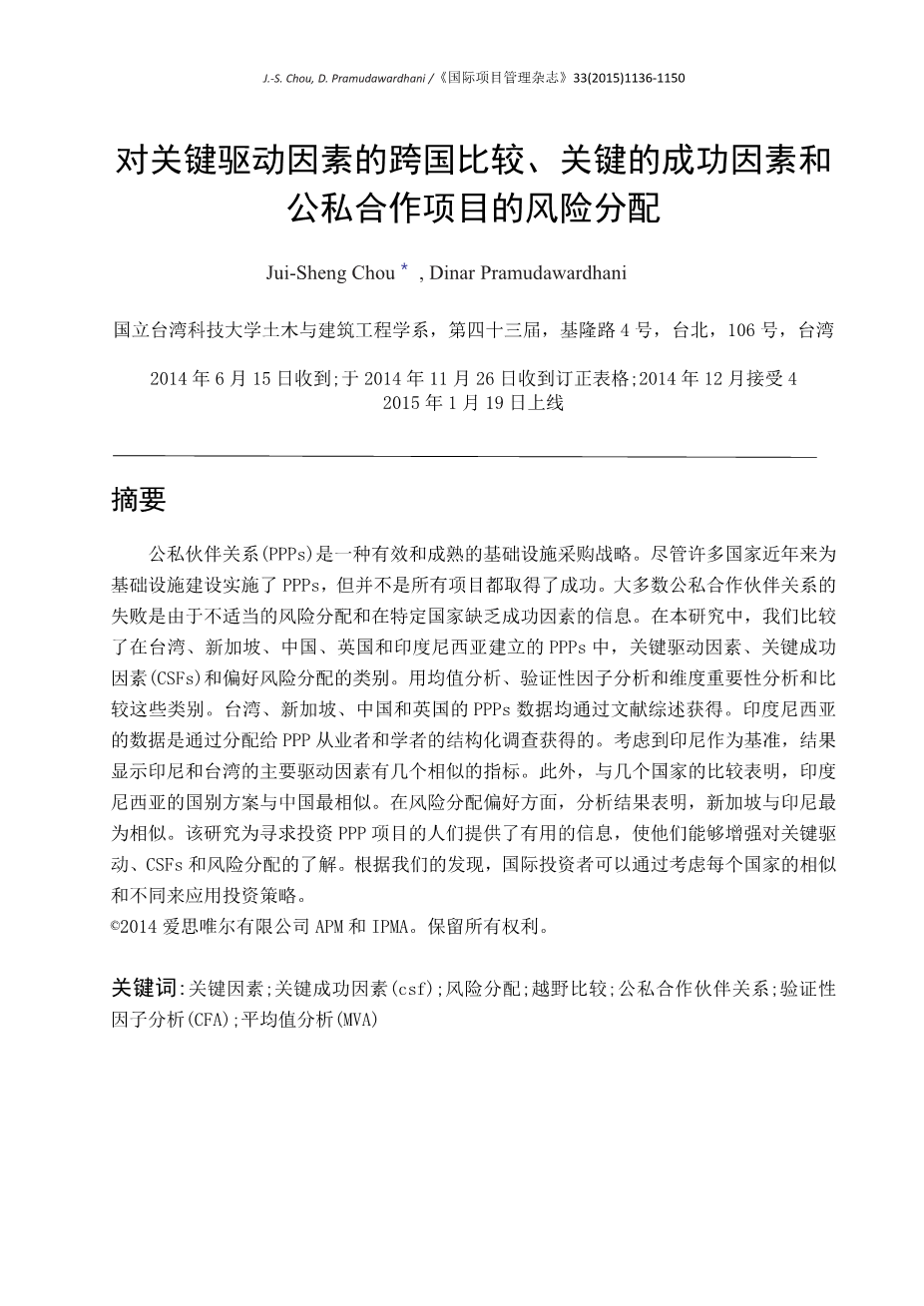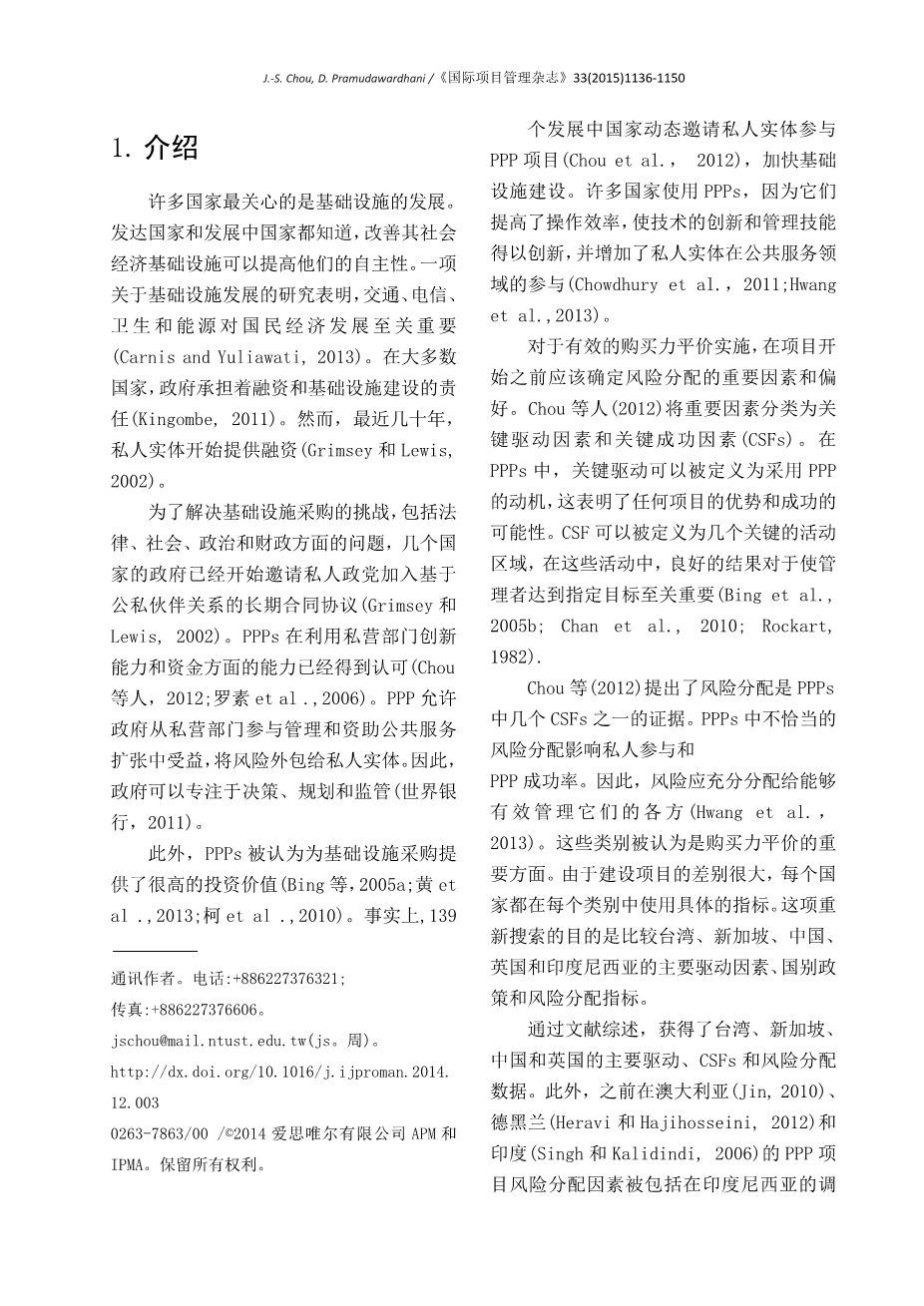Available online at www.sciencedirect.com
ScienceDirect
International Journal of Project Management 33 (2015) 1136 – 1150
www.elsevier.com/locate/ijproman
Cross-country comparisons of key drivers, critical success factors and risk allocation for public-private partnership projects
Jui-Sheng Chou ⁎, Dinar Pramudawardhani
Department of Civil and Construction Engineering, National Taiwan University of Science and Technology, 43, Sec. 4, Keelung Rd., Taipei, 106, Taiwan
Received 15 June 2014; received in revised form 26 November 2014; accepted 4 December 2014
Available online 19 January 2015
Abstract
Public-private partnerships (PPPs) are an effective and established strategy for procuring infrastructure. Although numerous countries have implemented PPPs for infrastructure development in recent years, not all projects have been successful. Most PPP failures result from inappropriate risk allocation and a lack of information on success factors in specific countries. For this study, we compared the categories of key drivers, critical success factors (CSFs), and preferred risk allocation in PPPs established in Taiwan, Singapore, China, the United Kingdom, and Indonesia. Mean value analysis, confirmatory factor analysis, and dimensional importance were used to analyze and compare these categories. Data on PPPs in Taiwan, Singapore, China, and the United Kingdom were obtained through comprehensive literature reviews. Data for Indonesia were obtained through structured surveys distributed to PPP practitioners and academicians. Considering Indonesia as the baseline, the results revealed that Indonesia and Taiwan exhibit several similar indicators of key drivers. Furthermore, comparisons with several countries revealed that Indonesian CSFs are most similar to those of China. Regarding risk allocation preference, the analytical results indicated that Singapore exhibits the most similarity with Indonesia. This study provides useful information for people seeking to invest in PPP projects, enabling them to enhance their understanding of key drivers, CSFs, and risk allocation in the researched countries. Based on our findings, international investors can apply investment strategies by considering the similarities and differences in each country.
copy; 2014 Elsevier Ltd. APM and IPMA. All rights reserved.
Keywords: Key drivers; Critical success factors (CSFs); Risk allocation; Cross-country comparison; Public-private partnership; Confirmatory factor analysis (CFA); Mean value analysis (MVA)
- Introduction
A major concern in numerous countries is infrastructure development. Both developed and developing countries acknowl- edge that improving their socioeconomic infrastructure can in- crease their autonomy. A study on infrastructure development showed that transportation, telecommunications, sanitation, and energy are essential for national economic development (Carnis and Yuliawati, 2013). In most countries, the government assumes responsibility for financing and building infrastructure (Kingombe, 2011). In recent decades, however, private entities have begun to provide financing (Grimsey and Lewis, 2002).
⁎ Corresponding author. Tel.: 886 2 2737 6321; fax: 886 2 2737 6606.
E-mail address: jschou@mail.ntust.edu.tw (J.-S. Chou).
To address the challenges of infrastructure procurement in- cluding legal, social, political, and financial concerns, the governments of several countries have begun to invite private parties to join long-term contractual agreements based on public-private partnerships (PPPs) (Grimsey and Lewis, 2002). The capability of PPPs in harnessing the innovative capability and capital of the private sector has been recognized (Chou et al., 2012; Russell et al., 2006). A PPP allows a government to benefit from the participation of the private sector in managing and financing public service expansion by outsourcing risk to private entities. Consequently, the government can focus on policymaking, planning, and regulation (The World Bank, 2011). Moreover, PPPs are believed to provide a high value for investments into infrastructure procurement (Bing et al., 2005a; Hwang et al., 2013; Ke et al., 2010). In fact, 139 developing
http://dx.doi.org/10.1016/j.ijproman.2014.12.003
0263-7863/00/copy; 2014 Elsevier Ltd. APM and IPMA. All rights reserved.
J.-S. Chou, D. Pramudawardhani / International Journal of Project Management 33 (2015) 1136–1150 1137
countries have dynamically invited private entities to participate in PPP programs (Chou et al., 2012) to accelerate infrastructure development. Numerous countries have used PPPs because they improve operational efficiency, enable the innovation of techno- logical and managerial skills, and increase the involvement of private entities in public services (Chowdhury et al., 2011; Hwang et al., 2013).
For effective PPP implementation, important factors and preferences regarding risk allocation should be identified before the commencement of a project. Chou et a
英语原文共 20 页,剩余内容已隐藏,支付完成后下载完整资料
资料编号:[11254],资料为PDF文档或Word文档,PDF文档可免费转换为Word




